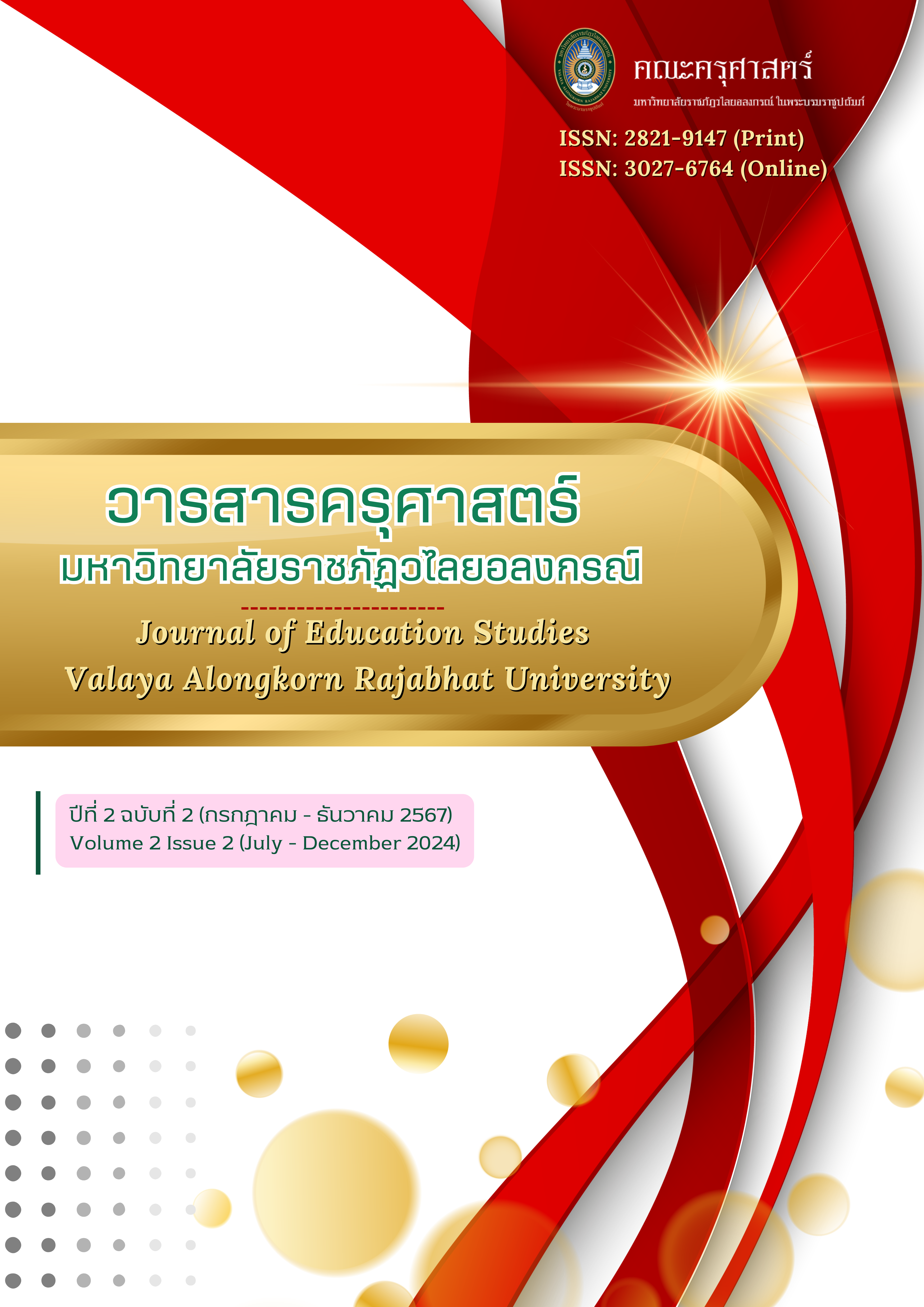Creating the Set of Science Learning Activity Based on the Concept of Inquiry and Model-Based Learning for Grade 3 Students
Keywords:
Science Learning Activity, Inquiry-Based Learning, Model-Based Learning, Teaching ScienceAbstract
The purposes of this research were to 1) create and find the effectiveness of the learning package designed based on the concepts of inquiry and model-based learning about the sun and earth, 2) compare pre and post scientific achievement after implementing the learning package and 3) compare the pre and post basic skills on scientific process after implementing the learning package. The sample group consisted of 20 third-grade students during the second semester of the 2021 academic year from an elementary school in Pathum Thani Province. The tools used in this research were a learning package designed based on the concept of inquiry and model-based learning. The statistics used for the data analysis included means, standard deviations, percents, and t-test for dependent samples. The results of the research were as follows: 1) learning management with the set of learning activities based on the concept of inquiry and model-based learning for grade 3 students had an efficiency value of 81.62/83.62, which was higher than the set threshold of 80/80, the science learning achievement of students were higher than the pre-test scores at the statistically significant level of .01, and the science process skills of students were higher than the pre-test scores at the statistically significant level of .01
References
กระทรวงศึกษาธิการ. (2551). หลักสูตรแกนกลางการศึกษาขั้นพื้นฐาน พุทธศักราช 2551. โรงพิมพ์ชุมนุมสหกรณ์การเกษตรแห่งประเทศไทย จำกัด. กรุงเทพฯ: กระทรวงศึกษาธิการ.
กระทรวงศึกษาธิการ. (2560). หลักสูตรแกนกลางการศึกษาขั้นพื้นฐาน พ.ศ. 2551 (ปรับปรุง พ.ศ. 2560) กระทรวงศึกษาธิการ. สืบค้นจาก https://academic.obec.go.th/web/document/view/131
ธันวาวุฒิ ดังชัยภูมิ และวิษณุ สุทธิวรรณ. (2562). การจัดการเรียนรู้โดยใช้ชุดกิจกรรม เรื่อง เซลล์ของสิ่งมีชีวิต ชั้นมัธยมศึกษาปีที่ 1 โรงเรียนชุมชนบ้านบุ่งคล้าวิทยา. วารสารสังคมศาสตร์วิจัย, 10(1), 104-115.
นันท์นภัส ปุราตาเน, อรสา จรูญธรรม และวิษณุ สุทธิวรรณ. (2562). การพัฒนาผลสัมฤทธิ์ทางการเรียนวิชาวิทยาศาสตร์ ของผู้เรียนชั้นประถมศึกษาปีที่ 4/5 โดยใช้เทคนิคเกมการสอน ประกอบการสอน แบบสืบเสาะ. วารสารวิชาการ คณะครุศาสตร์ มหาวิทยาลัยราชภัฏชัยภูมิ, 4(1), 22-29.
บุญชม ศรีสะอาด. (2541). การพัฒนาการสอน (พิมพ์ครั้งที่ 2). กรุงเทพฯ: สุวีริยาสาส์น.
บุญชม ศรีสะอาด. (2551). การวิจัยเบื้องต้น (พิมพ์ครั้งที่ 7). กรุงเทพฯ: สุวีริยาสาส์น.
พวงรัตน์ ทวีรัตน์. (2543). วิธีการวิจัยทางพฤติกรรมศาสตร์และสังคมศาสตร์ (พิมพ์ครั้งที่ 7). กรุงเทพฯ: สำนักทดสอบทางการศึกษาและจิตวิทยา มหาวิทยาลัยศรีนครินทรวิโรฒ.
สถาบันส่งเสริมการสอนวิทยาศาสตร์และเทคโนโลยี. (2555). คู่มือการจัดการเรียนรู้กลุ่มสาระวิทยาศาสตร์. กรุงเทพฯ: สถาบันส่งเสริมการสอนวิทยาศาสตร์และเทคโนโลยี.
สถาบันส่งเสริมการสอนวิทยาศาสตร์และเทคโนโลยี. (2564). ผลการประเมินการอ่าน คณิตศาสตร์ และวิทยาศาสตร์ PISA 2018. กรุงเทพฯ: สถาบันส่งเสริมการสอนวิทยาศาสตร์และเทคโนโลยี.
สำนักงานเลขาธิการสภาการศึกษา. (2560). แผนการศึกษาแห่งชาติ พ.ศ. 2560-2579 (พิมพ์ครั้งที่ 2). กรุงเทพฯ: สำนักพิมพ์ สกสค.
อนิวรรต ภูครองหิน และพัชรินทร์ วัฒนราช. (2563). การพัฒนาชุดกิจกรรมการเรียนรู้ตามกระบวนการสืบเสาะหาความรู้ (5E) เรื่องพลังงานไฟฟ้า วิชาวิทยาศาสตร์ สำหรับชั้นมัธยมศึกษาปีที่ 3. วารสารวิชาการมหาวิทยาลัยราชภัฏภูเก็ต, 16(2), 42-57
Açişli, S., Yalçin, S. A., & Turgut, Ü. (2011). Effects of the 5E learning model on students’ academic achievements in movement and force issues. Procedia - Social and Behavioral Sciences, 15, 2459–2462. Retrieved from https://doi.org/10.1016/j.sbspro.2011.04.128
Akinyemi Omotayo, S., & Oluwatoyin Adeleke, J. (2017). The 5E Instructional Model: a Constructivist Approach for Enhancing Students’ Learning Outcomes in Mathematics. JISTE, 21(2), 15-26.
Chompuwiset, K., & Chompuwiset, P. (2020). The Study of Learning Achievement, Science Process Skills and Satisfaction by Using Learning Activities on Local Medicinal Herbs for Mathayomsuksa 2 Students. Social Sciences Research and Academic Journal, 15(2), 29-42.
Dangchaiyaphum, T., & Suttiwan, W. (2019). Learning management by using the activity package in cell for grade 7 students in chumchon ban bungkhla witthaya school. Journal for social sciences research, 10(1), 104-115.
Duran, L. B., & Duran, E. (2004). The 5E Instructional Model: A Learning Cycle Approach for Inquiry-Based Science Teaching. The Science Education Review, 3(2), 49-58.
Gaysornbou, Y., Mektrirat, W., & Insombat, B. (2018). Results from the Use of Experience Enhancing Activities Towards the Scientific Process Skills of the Preschool Children. Social Sciences Research and Academic Journal, 13(39), 85–98.
Maison, M., Darmaji, D., & Kurniawan, D. A. (2019). Science process skills and motivation. Humanities and Social Sciences Reviews, 7(5), 48–56. Retrieved from https://doi.org/10.18510/hssr.2019.756
Park, J., Chang, J., Tang, K. S., Treagust, D. F., & Won, M. (2020). Sequential patterns of students’ drawing in constructing scientific explanations: focusing on the interplay among three levels of pictorial representation. International Journal of Science Education, 42(5), 677-702. Retrieved from https://doi.org/10.1080/09500693.2020.1724351
Rodriguez, S., Allen, K., Harron, J., & Qadri, S. A. (2019). Making and the 5E Learning Cycle. The Science Teacher, 86(05), 48-55. Retrieved from https://doi.org/10.2505/4/tst18_086_05_48
Rosenblueth, A., & Wiener, N. (1945). The Role of Models in Science. Philosophy of Science. Philosophy of Science, 12(4), 316-321.
Saisongkhroh, B. (2017). The Development of a Learning Package Activities in Line of Inquiry Learning Cycle Entitle “Cell and Life Processes of Plants” Mattayom Suksa 1. Journal of Kasetsart Educational Review, 32(1), 28-35.
Shortland, M., & Gregory, J. (1991). Communicating Science. Longman Scientific. Michigan: Longman Scientific.
Siti, D., Pg, N., & Besar, H. (2018). Situated Learning Theory: The Key to Effective Classroom Teaching?. Indonesia: Minda Masagi Press.
Thanjai, T., Suttiwan, W., & Pinthong, T. (2021). Using the scientific models to promote analytical thinking ability and learning achievement of the solar system of grade 9th students. Ournal of Humanities and Social Science Valaya Alongkorn, 16(1), 31-47.
Treagust, D., & Chittleborough, G. D. (2009). Why Models are Advantageous to Learning Science. Educación Química, 20(1), 12-17. Retrieved from https://doi.org/10.1016/S0187-893X(18)30003-X
Wattanawikkid, N. (2016). The Effects of a Science Process Skill Development Activity Package on Science Learning Achievement in the Topic of Substances and Their Properties and Science Process Skills of Mathayom Suksa I Students at Chomsurang Upatham School in Phra Nakhon Si Ayutthaya Province. Veridian E-Journal, Silpakorn University, 9(1), 1595-1605.







